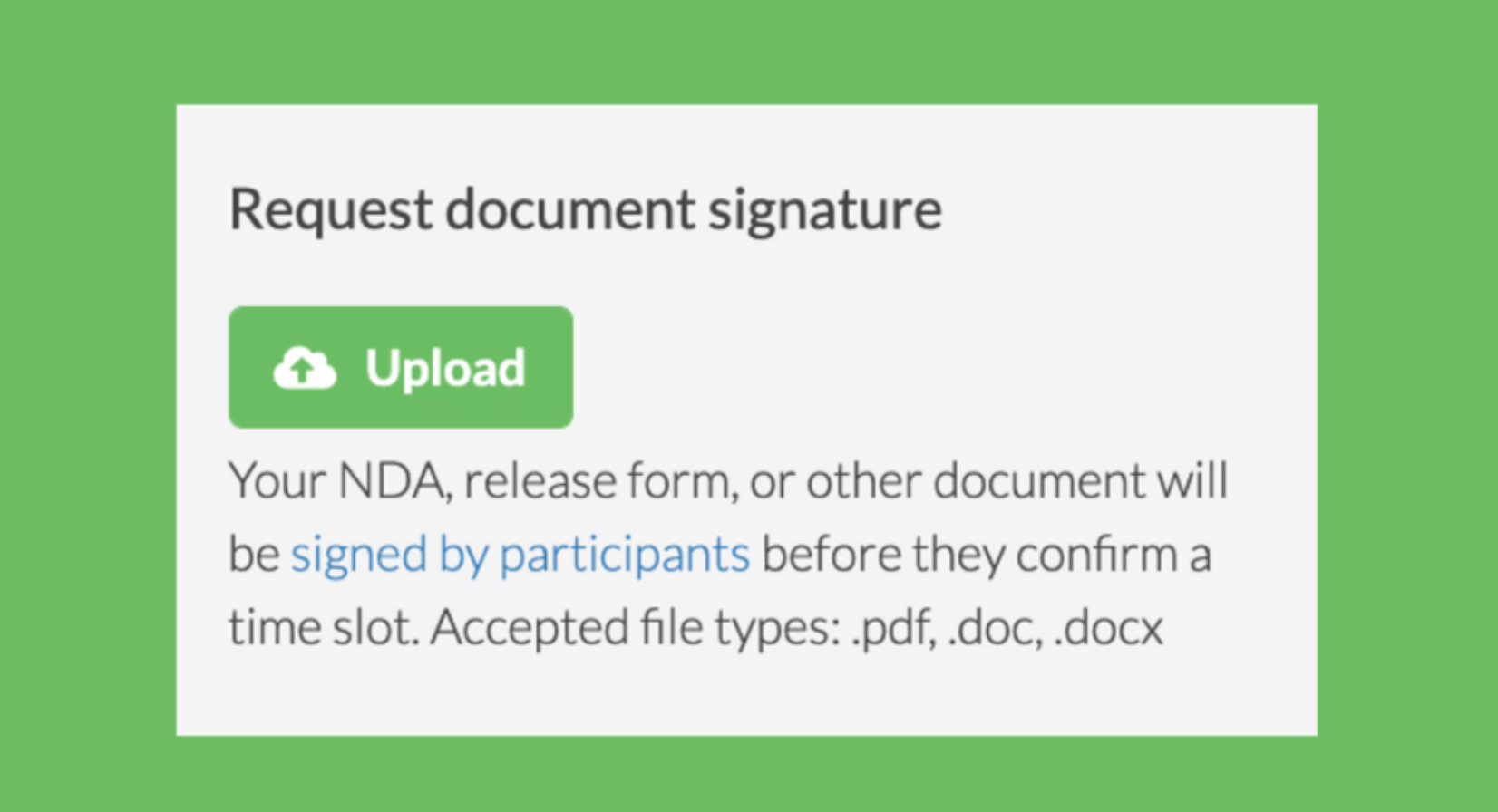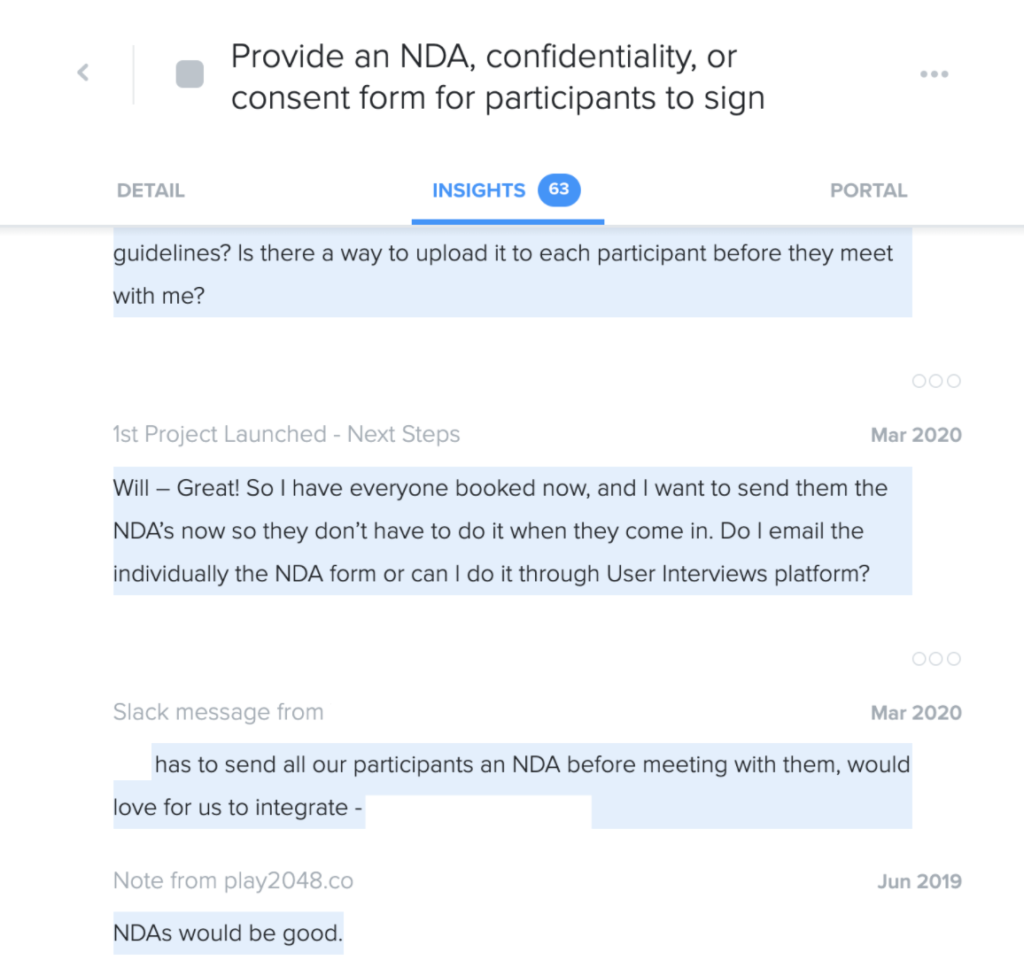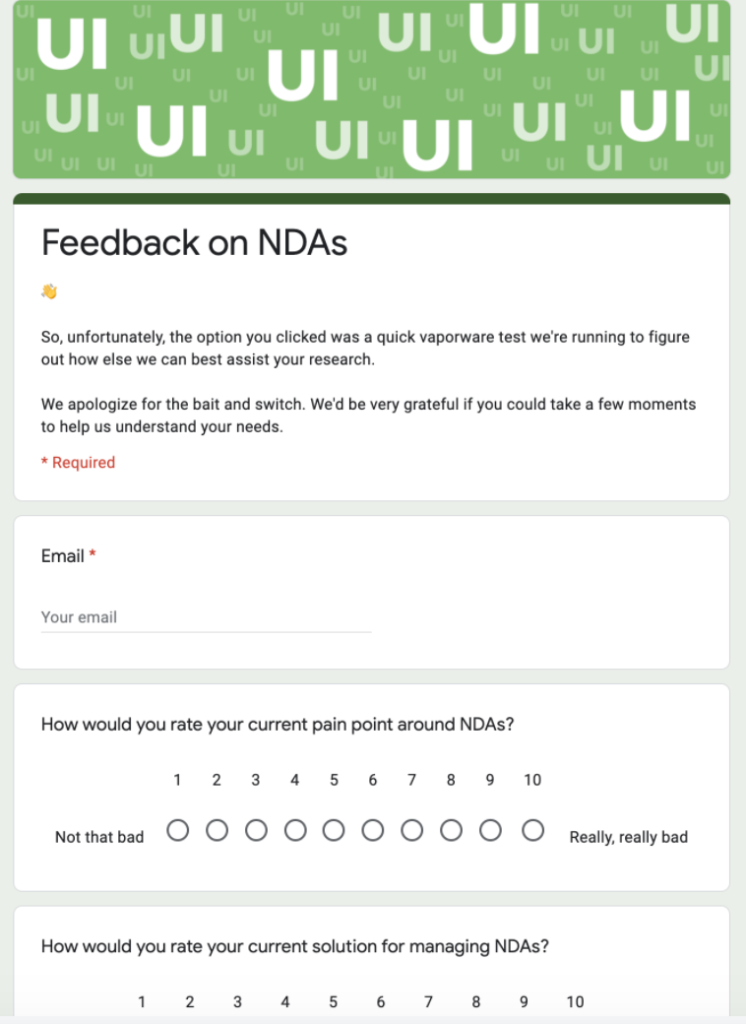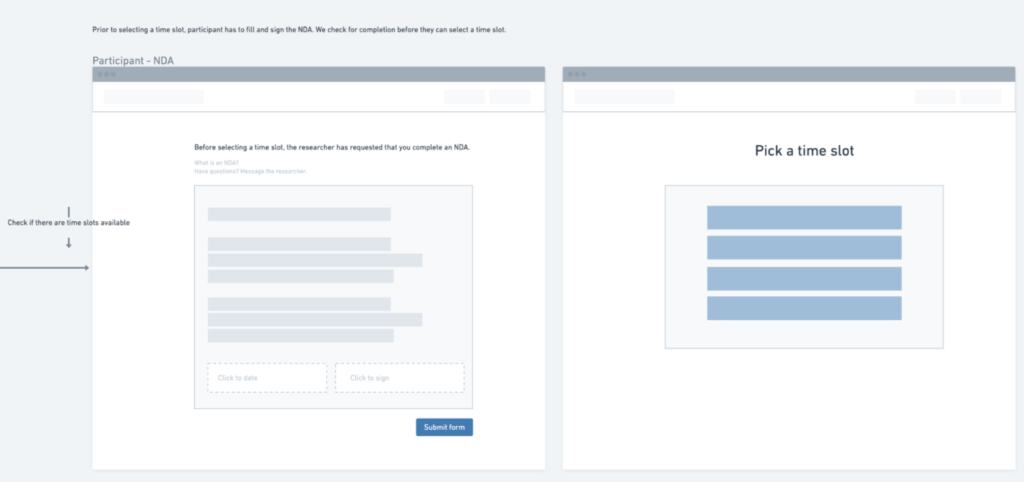How we built this: User Interviews’ Document Signing feature

Since 2015, User Interviews has helped researchers talk to their users, gather feedback, and make better product decisions.
But how does a software company built around deep user research launch a new feature before it’s quite ready—especially one with a unique pricing model in a competitive market?
That was the challenge faced by senior product manager Wen Zeng with one of the company’s latest experiments: Document Signing. An experienced product designer and product manager, Zeng cut her teeth in the pixel-perfect world of agency design—a stark contrast to the fast-paced action of leading the growth team at User Interviews.

With Document Signing, User Interviews removes a huge pain point for researchers tasked with ensuring important agreements are signed by participants before each session. But launching Document Signing represented a substantial risk—both for Zeng’s reputation on the growth team and for User Interviews’ bottom line.
Spoiler alert: the launch went off without a hitch, and the feature rapidly became an essential part of User Interviews’ offering. I sat down with Zeng to find out how she and her team built Document Signing together, and to share some of the important lessons she learned throughout the process.
Finding a competitive advantage in a crowded market
The idea for adding NDA support to User Interviews had been floating around for some time before Zeng and the team first considered adding it to the roadmap in May of 2020.
Researchers, legal teams, and other departments frequently need non-disclosure agreements (NDAs), consent forms, and other documents signed by participants before each session. But far too often, participants forget to sign the required documents, meaning researchers have to reschedule the session—or worse, find an entirely new set of participants.
The team had been collecting feedback on this pain point for a while. “We were collecting feedback in Productboard from users who wanted to be able to sign NDAs before research sessions, or complaining that the process was complex for them because they had external document signing software that wasn’t closely integrated with User Interviews.”

Document signing isn’t new. Plenty of competing document-signing solutions were already on the market. But the real value in integrating document signing into User Interviews wasn’t so much in the ease of signing documents.
Instead, Zeng discovered that researchers were frustrated most by the inability to guarantee that essential documents were signed before each research session. “Teams would already be using DocuSign or another solution, but participants would regularly show up at the session having not signed their documents, and they would have to cancel the whole thing and re-recruit.”
That feedback gave Wen the confidence she needed to move ahead with running a more extensive test around the NDA feature.
How User Interviews interviews users before building products
Building new features is hard—and expensive. Yet many teams continue building new products and features in the dark, only to see them go underutilized after launch.
The solution: product discovery. Taking the time to validate new features and refine ideas before landing on the best way to solve the problem is the key to a successful launch.
As you’d expect from a company selling research software, User Interviews has a strong product validation process. Before diving into building Document Signing, Zeng set out to test whether the value of guaranteeing a signed document before a research session was worth the additional cost and headache of replacing existing document signing solutions.
To help validate the feature without spending a ton of time, the team ran a vaporware test throughout the User Interviews app. The vaporware test pre-announced two different things: a post-interview transcription service and an NDA signing feature. Out of 150 researchers who saw the modal, 52% ended up picking the NDA feature, proving it to be the more desirable feature of the two.
After selecting the feature, users were directed to a simple Google Form that collected information on how big of a pain point NDA signing was for them and what features they might want to see included within User Interviews. That gave Wen and the team enough data to move forward.

Zeng then followed up with those who responded to the vaporware test, sharing low-fidelity wireframes of the proposed feature to gather early feedback.

Zeng’s research quickly proved its value: one of the first things the team discovered was that describing the feature as “NDA signing” quickly became too confining. “Sometimes researchers are looking to have participants sign a full NDA”, Zeng explains, “but other times they’re simply looking for consent to use photos or videos. That’s how we ended up with the name Document Signing—because you can sign any sort of documents that need signing before a research session.”
A fortuitous growth experiment—and a lesson in lessening
User Interviews splits their development teams into two different squads: Core and Growth. Zeng explains how she’s part of the growth team—a group of designers, engineers, and PMs responsible for testing out new ideas. Concepts that make the cut—like Document Signing, or a recent Zoom integration—are then handed off to a Core squad who take ownership of the logistics behind expanding the feature and readying it for prime-time.
Document Signing followed the same path. After spending a few months researching, Zeng’s growth team began building the feature in earnest in August of 2020, with Zeng acting as designer and product manager alongside a single developer tasked with building out the feature.
Of course, launching an extensive feature like Document Signing on schedule with such a lean team meant success stemmed more from what the team chose not to build than what ended up being included. The best product roadmaps come from PMs who are ruthless when it comes to choosing what to build.
One area the team was able to expedite the process around was the document signing workflow itself. Instead of building a signature tool from scratch, Zeng ended up integrating HelloSign’s standard API into User Interviews to power the signature collection portion of the workflow.
As any PM might, that still didn’t stop Zeng from dreaming big. “It was a challenge for me to narrow down the scope,” she laughs. “It was interesting to think through what it would be like to integrate with multiple [document-signing tools] and let researchers choose whichever platforms they already had accounts with. But building out five of these integrations sounded a little insane, and provided a lot more pricing challenges than sticking with a single tool.”
A stronger-than-expected reception for an unusual pricing model
Product differentiation is a key part of any PM’s overall product strategy. It details what sets your product apart from your competitors—what makes it unique.
That uniqueness doesn’t only apply to product functionality. Great design, opinionated copywriting, and even pricing are other key characteristics that set your product apart.
Exploring User Interviews’ pricing page, I was surprised to discover that the Document Signing feature followed a less-than-common pricing model among SaaS companies.
Instead of including Document Signing as part of the existing Starter or Essentials pricing packages, User Interviews requires users to pay an additional $50-100 a month to unlock the feature.

When I asked Zeng about this, she explains that by letting customers opt-in to the service rather than including it in all plans, the team ensured only customers who truly needed the software would sign up. Since User Interviews also pays HelloSign by API call, keeping the feature as a paid add-on helped to minimize unnecessary operating costs. “We really wanted this to be something people were using intentionally,” Zeng shares.
“The adoption rate has been much higher than we anticipated,” Zeng reveals.
Her initial growth goal was to sign up 16 teams in the first 60 days after launching in November of 2020. The team ended up signing their 16th customer in just 30 days. As of writing, Document Signing has 79 teams actively using the feature, with over 7,000 documents having been signed by research participants—a successful result by any measure.
Three lessons PMs can take from Document Signing
There’s a lot to learn from Zeng’s experience launching Document Signing—here are just a few of the most important takeaways:
Lesson #1: Get crystal clear on your value proposition—then ruthlessly stick to it
Document Signing’s unique selling proposition lay in the ability to guarantee that documents would be signed before participants could even choose a time slot for their research session.
- Avoid forming preconceived notions of your product’s true value. Customer feedback is the best source of insights about your true unique selling proposition.
- If you’re improving an existing feature, ask your present customers about the #1 thing your product does they can’t live without—there’s a good chance that’s your USP.
- Once you’ve identified your USP, use it as a lens for every product decision. Does a new feature enhance the core value of your product, or is it simply a distraction? Viewing every product decision through this lens will help avoid product bloat.
Lesson #2: Test early, test often
Testing out new feature ideas through a vaporware test is a great way to validate the demand for larger features—and to begin gathering valuable user insights—before you begin building.
- Avoid falling in love with your ideas. To emotionally disconnect from your ideas, build a hypothesis statement detailing the actions, outcomes, and theory behind your experiment.
- Testing rough wireframes early on in the process and getting feedback that you’re building the right thing can be highly motivating. It also gives you a quick way to pivot on the design before any development time goes into the feature.
Lesson #3: Testing the value of your product doesn’t end with your roadmap
The initial launch of Document Signing didn’t include all the features Zeng might have wanted—but even with those missing features, the product was still worth paying hundreds of dollars a month for.
Like the feature itself, pricing gives you a way of experimenting and testing the value provided by the service. “It turns out that convenience is a huge selling point for people because chasing down people for documents is not something people want to spend time on at work.”
- Before launching a new feature, consider the relative importance of that feature to the rest of your product. Does it make sense to include it as a core feature—or can you extract additional revenue by pricing as an additional feature, like Document Signing?
The finest feedback a PM can receive
When I asked Zeng about the biggest lesson she learned while launching Document Signing, she chuckled.
“A good personal lesson for me was being okay with something I knew wasn’t perfect,” she tells me. “Prior to User Interviews, I worked at a design consultancy where everything needed to be pixel-perfect before launch—a huge contrast to working at a more fast-paced software startup.”
But as one would expect from a company whose foundation is built on user research, Document Signing is grounded not in one PM’s instincts but in thorough research and analysis. “One of the most validating things I heard,” Wen told me as we wrapped up our interview, “was when someone said, ‘This is exactly what I was thinking of’. Knowing that we’re providing a solution that no one else was made the whole process worthwhile.”




![The CPO’s Blueprint for Annual Planning: An Opportunity to Drive Change [Part 3]](https://www.productboard.com/wp-content/uploads/2024/11/strategy-blueprint-560x293.png)

